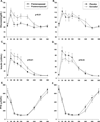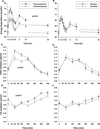Postprandial triglycerides and adipose tissue storage of dietary fatty acids: impact of menopause and estradiol
- PMID: 25354893
- PMCID: PMC4276527
- DOI: 10.1002/oby.20935
Postprandial triglycerides and adipose tissue storage of dietary fatty acids: impact of menopause and estradiol
Abstract
Objectives: Postprandial lipemia worsens after menopause, but the mechanism remains unknown. The hypothesized menopause-related postprandial lipemia would be (1) associated with reduced storage of dietary fatty acids (FA) as triglyceride (TG) in subcutaneous adipose tissue (SAT) and (2) improved by short-term estradiol (E2 ).
Methods: Twenty-three pre- (mean ± SD: 42 ± 4 years) and 22 postmenopausal (55 ± 4 years) women with similar total adiposity were studied. A subset of postmenopausal women (n = 12) were studied following 2 weeks of E2 (0.15 mg) and matching placebo in a random, cross-over design. A liquid meal containing (14) C-oleic acid traced appearance of dietary FA in: serum (postprandial TG), breath (oxidation), and abdominal and femoral SAT (TG storage).
Results: Compared to premenopausal women, healthy, lean, postmenopausal women had increased postprandial glucose and insulin and trend for higher TG but had similar dietary FA oxidation and storage. Adipocytes were larger in post- compared to premenopausal women, particularly in femoral SAT. Short-term E2 reduced postprandial TG and insulin but had no effect on oxidation or storage of dietary FA. E2 increased the proportion of small adipocytes in femoral (but not abdominal) SAT.
Conclusions: Short-term E2 attenuated menopause-related increases in postprandial TG and increased femoral adipocyte hyperplasia but not through increased net storage of dietary FA.
© 2014 The Obesity Society.
Conflict of interest statement
Figures




Similar articles
-
Femoral lipectomy increases postprandial lipemia in women.Am J Physiol Endocrinol Metab. 2015 Jul 1;309(1):E63-71. doi: 10.1152/ajpendo.00080.2015. Epub 2015 May 12. Am J Physiol Endocrinol Metab. 2015. PMID: 25968576 Free PMC article. Clinical Trial.
-
Adipocyte fatty acid storage factors enhance subcutaneous fat storage in postmenopausal women.Diabetes. 2013 Mar;62(3):775-82. doi: 10.2337/db12-0912. Epub 2012 Dec 3. Diabetes. 2013. PMID: 23209188 Free PMC article.
-
Overweight postmenopausal women with different plasma estradiol concentrations present with a similar pattern of energy expenditure and substrate oxidation rate before and after a fatty meal challenge.Clin Nutr ESPEN. 2016 Oct;15:21-27. doi: 10.1016/j.clnesp.2016.05.003. Epub 2016 Jun 2. Clin Nutr ESPEN. 2016. PMID: 28531779
-
Impact of Meal Fatty Acid Composition on Postprandial Lipemia in Metabolically Healthy Adults and Individuals with Cardiovascular Disease Risk Factors: A Systematic Review.Adv Nutr. 2022 Feb 1;13(1):193-207. doi: 10.1093/advances/nmab096. Adv Nutr. 2022. PMID: 34427586 Free PMC article.
-
Tracing the fate of dietary fatty acids: metabolic studies of postprandial lipaemia in human subjects.Proc Nutr Soc. 2011 Aug;70(3):342-50. doi: 10.1017/S002966511100084X. Proc Nutr Soc. 2011. PMID: 21781361 Review.
Cited by
-
Age But Not Menopausal Status Is Linked to Lower Resting Energy Expenditure.J Clin Endocrinol Metab. 2023 Oct 18;108(11):2789-2797. doi: 10.1210/clinem/dgad321. J Clin Endocrinol Metab. 2023. PMID: 37265230 Free PMC article.
-
Inflammatory and lipemic response to red meat intake in women with and without Rheumatoid Arthritis: a single meal study within a randomized controlled trial.BMC Nutr. 2025 Apr 11;11(1):74. doi: 10.1186/s40795-025-01055-9. BMC Nutr. 2025. PMID: 40217385 Free PMC article.
-
Sex differences in the metabolism of glucose and fatty acids by adipose tissue and skeletal muscle in humans.Physiol Rev. 2025 Jul 1;105(3):897-934. doi: 10.1152/physrev.00008.2024. Epub 2025 Jan 27. Physiol Rev. 2025. PMID: 39869194 Review.
-
Region-specific effects of oestradiol on adipose-derived stem cell differentiation in post-menopausal women.J Cell Mol Med. 2017 Apr;21(4):677-684. doi: 10.1111/jcmm.13011. Epub 2016 Nov 15. J Cell Mol Med. 2017. PMID: 27862950 Free PMC article.
-
Femoral lipectomy increases postprandial lipemia in women.Am J Physiol Endocrinol Metab. 2015 Jul 1;309(1):E63-71. doi: 10.1152/ajpendo.00080.2015. Epub 2015 May 12. Am J Physiol Endocrinol Metab. 2015. PMID: 25968576 Free PMC article. Clinical Trial.
References
-
- Frayn KN. Adipose tissue as a buffer for daily lipid flux. Diabetologia. 2002;45:1201–1210. - PubMed
-
- Couillard C, Bergeron N, Prud'homme D, Bergeron J, Tremblay A, Bouchard C, et al. Gender difference in postprandial lipemia: Importance of visceral adipose tissue accumulation. Arterioscler Thromb Vasc Biol. 1999;19(10):2448–2455. - PubMed
-
- Horton TJ, Commerford SR, Pagliassotti MJ, Bessesen DH. Postprandial leg uptake of triglyceride is greater in women than in men. Am J Physiol: Endocrin Metab. 2002;283(6):E1192–E1202. - PubMed
-
- van Beek AP, de Ruijter-Heijstek FC, Erkelens DW, de Bruin TW. Menopause is associated with reduced protection from postprandial lipemia. Arterioscler Thromb Vasc Biol. 1999;19(11):2737–2741. - PubMed
-
- Westerveld HT, Kock LA, van Rijn HJ, Erkelens DW, de Bruin TW. 17 beta-Estradiol improves postprandial lipid metabolism in postmenopausal women. J Clin Endocrinol Metab. 1995;80(1):249–253. - PubMed
Publication types
MeSH terms
Substances
Grants and funding
- K24 DK002935/DK/NIDDK NIH HHS/United States
- P30 DK048520/DK/NIDDK NIH HHS/United States
- R01 DK038088/DK/NIDDK NIH HHS/United States
- R01 DK077992/DK/NIDDK NIH HHS/United States
- UL1 TR000154/TR/NCATS NIH HHS/United States
- DK088105/DK/NIDDK NIH HHS/United States
- DK038088/DK/NIDDK NIH HHS/United States
- K12 HD057022/HD/NICHD NIH HHS/United States
- P50 HD073063/HD/NICHD NIH HHS/United States
- AG000279/AG/NIA NIH HHS/United States
- R01 DK088105/DK/NIDDK NIH HHS/United States
- DK002935/DK/NIDDK NIH HHS/United States
- UL1 TR001082/TR/NCATS NIH HHS/United States
- DK077992/DK/NIDDK NIH HHS/United States
- T32 AG000279/AG/NIA NIH HHS/United States
- HD057022/HD/NICHD NIH HHS/United States
LinkOut - more resources
Full Text Sources
Other Literature Sources
Medical
Research Materials
Miscellaneous

